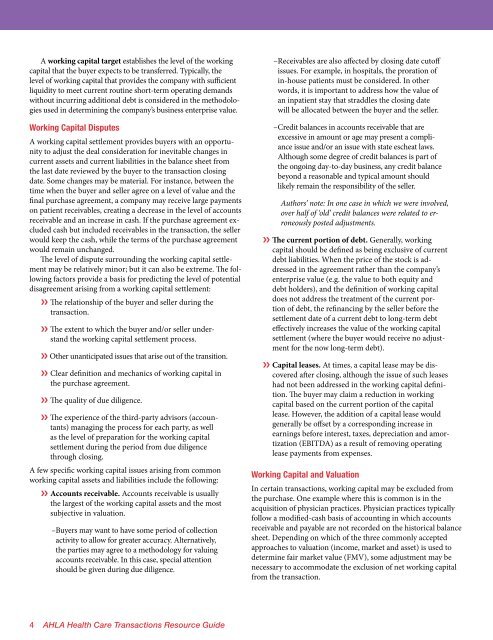1g8lWSM
1g8lWSM
1g8lWSM
You also want an ePaper? Increase the reach of your titles
YUMPU automatically turns print PDFs into web optimized ePapers that Google loves.
A working capital target establishes the level of the working<br />
capital that the buyer expects to be transferred. Typically, the<br />
level of working capital that provides the company with sufficient<br />
liquidity to meet current routine short-term operating demands<br />
without incurring additional debt is considered in the methodologies<br />
used in determining the company’s business enterprise value.<br />
Working Capital Disputes<br />
A working capital settlement provides buyers with an opportunity<br />
to adjust the deal consideration for inevitable changes in<br />
current assets and current liabilities in the balance sheet from<br />
the last date reviewed by the buyer to the transaction closing<br />
date. Some changes may be material. For instance, between the<br />
time when the buyer and seller agree on a level of value and the<br />
final purchase agreement, a company may receive large payments<br />
on patient receivables, creating a decrease in the level of accounts<br />
receivable and an increase in cash. If the purchase agreement excluded<br />
cash but included receivables in the transaction, the seller<br />
would keep the cash, while the terms of the purchase agreement<br />
would remain unchanged.<br />
The level of dispute surrounding the working capital settlement<br />
may be relatively minor; but it can also be extreme. The following<br />
factors provide a basis for predicting the level of potential<br />
disagreement arising from a working capital settlement:<br />
❯❯ The relationship of the buyer and seller during the<br />
transaction.<br />
❯❯ The extent to which the buyer and/or seller understand<br />
the working capital settlement process.<br />
❯❯ Other unanticipated issues that arise out of the transition.<br />
❯❯ Clear definition and mechanics of working capital in<br />
the purchase agreement.<br />
❯❯ The quality of due diligence.<br />
❯❯ The experience of the third-party advisors (accountants)<br />
managing the process for each party, as well<br />
as the level of preparation for the working capital<br />
settlement during the period from due diligence<br />
through closing.<br />
A few specific working capital issues arising from common<br />
working capital assets and liabilities include the following:<br />
❯❯ Accounts receivable. Accounts receivable is usually<br />
the largest of the working capital assets and the most<br />
subjective in valuation.<br />
–Buyers may want to have some period of collection<br />
activity to allow for greater accuracy. Alternatively,<br />
the parties may agree to a methodology for valuing<br />
accounts receivable. In this case, special attention<br />
should be given during due diligence.<br />
–Receivables are also affected by closing date cutoff<br />
issues. For example, in hospitals, the proration of<br />
in-house patients must be considered. In other<br />
words, it is important to address how the value of<br />
an inpatient stay that straddles the closing date<br />
will be allocated between the buyer and the seller.<br />
–Credit balances in accounts receivable that are<br />
excessive in amount or age may present a compliance<br />
issue and/or an issue with state escheat laws.<br />
Although some degree of credit balances is part of<br />
the ongoing day-to-day business, any credit balance<br />
beyond a reasonable and typical amount should<br />
likely remain the responsibility of the seller.<br />
Authors’ note: In one case in which we were involved,<br />
over half of ‘old’ credit balances were related to erroneously<br />
posted adjustments.<br />
❯❯ The current portion of debt. Generally, working<br />
capital should be defined as being exclusive of current<br />
debt liabilities. When the price of the stock is addressed<br />
in the agreement rather than the company’s<br />
enterprise value (e.g. the value to both equity and<br />
debt holders), and the definition of working capital<br />
does not address the treatment of the current portion<br />
of debt, the refinancing by the seller before the<br />
settlement date of a current debt to long-term debt<br />
effectively increases the value of the working capital<br />
settlement (where the buyer would receive no adjustment<br />
for the now long-term debt).<br />
❯❯ Capital leases. At times, a capital lease may be discovered<br />
after closing, although the issue of such leases<br />
had not been addressed in the working capital definition.<br />
The buyer may claim a reduction in working<br />
capital based on the current portion of the capital<br />
lease. However, the addition of a capital lease would<br />
generally be offset by a corresponding increase in<br />
earnings before interest, taxes, depreciation and amortization<br />
(EBITDA) as a result of removing operating<br />
lease payments from expenses.<br />
Working Capital and Valuation<br />
In certain transactions, working capital may be excluded from<br />
the purchase. One example where this is common is in the<br />
acquisition of physician practices. Physician practices typically<br />
follow a modified-cash basis of accounting in which accounts<br />
receivable and payable are not recorded on the historical balance<br />
sheet. Depending on which of the three commonly accepted<br />
approaches to valuation (income, market and asset) is used to<br />
determine fair market value (FMV), some adjustment may be<br />
necessary to accommodate the exclusion of net working capital<br />
from the transaction.<br />
4 AHLA Health Care Transactions Resource Guide


